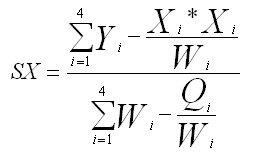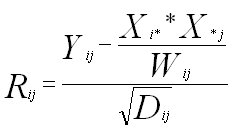
|
Notation
|
Description
|
|---|---|
|
W i
|
Sum of the weights (weighted base) for column i.
|
|
Q i
|
Sum of the squared weights for column i.
|
|
E i = (W i * W i) / Q i
|
Effective base for column i.
|
|
P i
|
Proportion in column i
|
|
Notation
|
Description
|
|---|---|
|
W ij
|
Sum of the weights (weighted base) for respondents in both columns.
|
|
Q ij
|
Sum of the squared weights for respondents in both columns.
|
|
E ij = (W ij * W ij) / Q ij
|
Effective base for respondents in both columns.
|
|
P ij
|
Proportion for respondents belonging in the row being tested for both columns.
|









Notation | Description |
|---|---|
W i | Sum of the weighted base for column i. |
Q i | Sum of the squared weights for column i. |
E i = (W i * W i) / Q i | Effective base for column i. |
X i | sum of values for column i |
Y i | sum of squared values for column i |
M i | mean for column i=X i/W i |
Notation | Description |
|---|---|
W ij | Sum of the weighted base for respondents in both columns. |
Q ij | Sum of the squared weights for respondents in both columns. |
E ij = (W ij * W ij) / Q ij | Effective base for respondents in both columns. |





Notation | Description |
|---|---|
X i* | The weighted sum of factors for column i for all respondents belonging in the mean for column i and in the base of column j. |
X *j | The weighted sum of factors for column j for all respondents belonging in the mean for column j and in the base of column i. |
Y i* | The weighted sum of squared factors for column i for all respondents belonging in the mean for column i and in the base of column j |
Y *j | The weighted sum of squared factors for column j for all respondents belonging in the mean for column j and in the base of column i |
Y ij | The weighted sum of (factor for column i) * (factor for column j) for all respondents belonging in the mean for both columns. |






